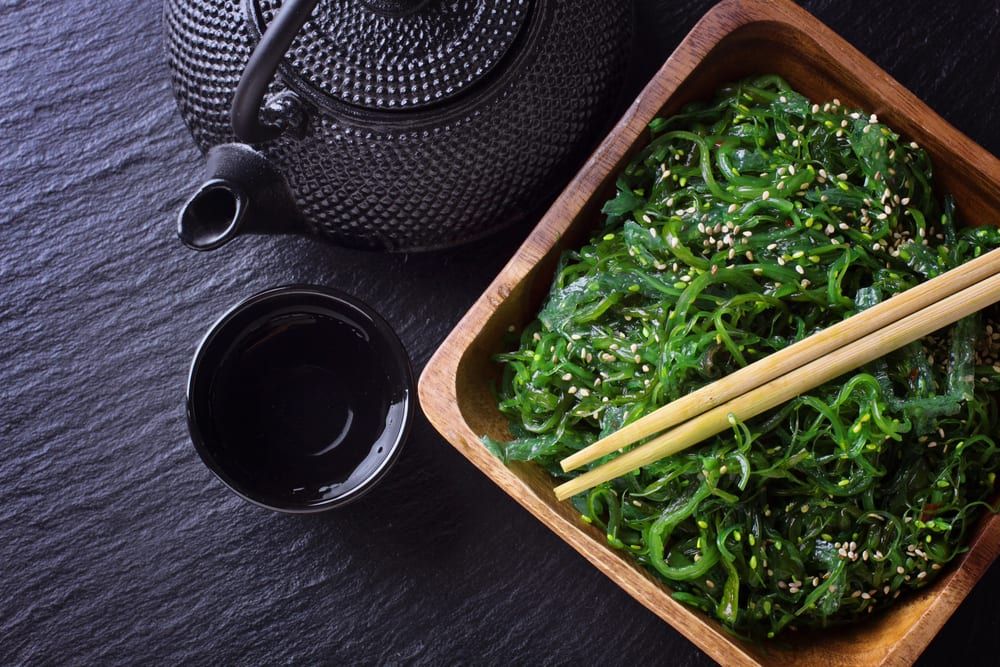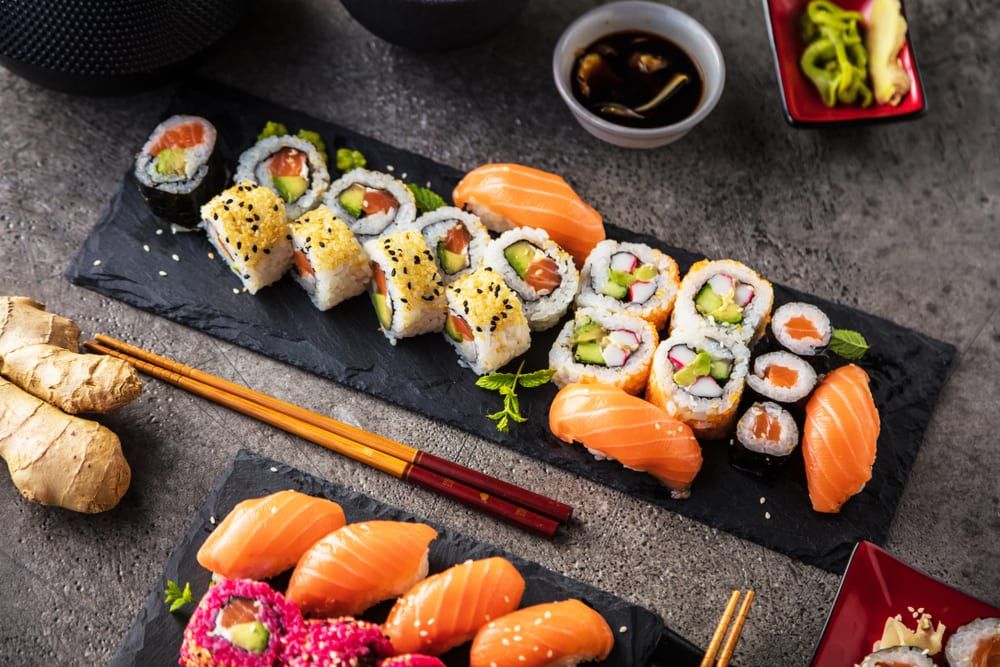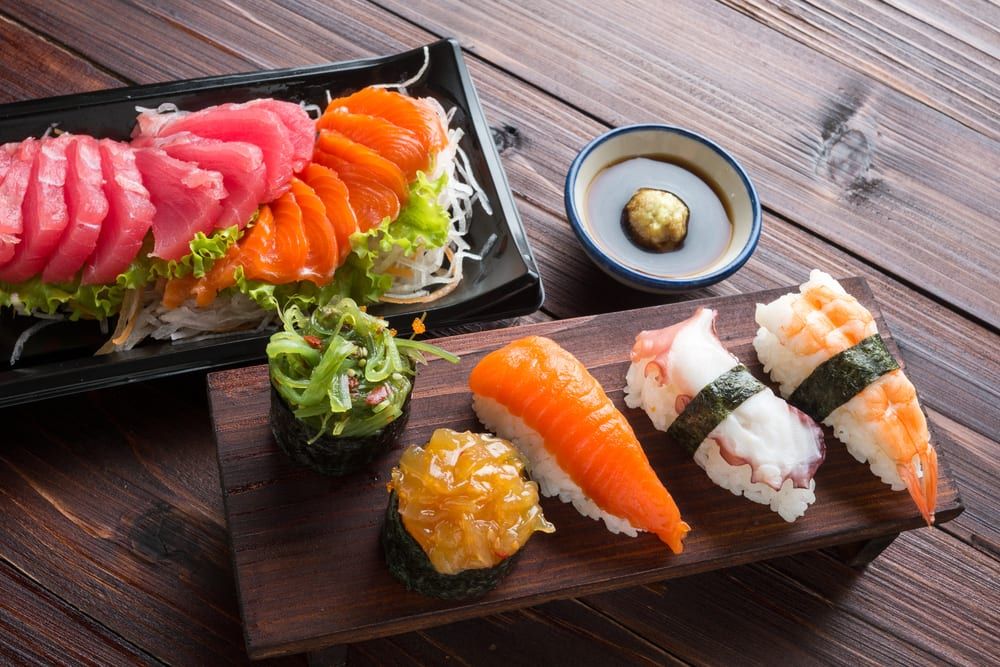Sushi is one of the most requested food types for office lunches, and for good reason. It’s healthy, delicious, and has that certain “special occasion’ feeling that makes a catered lunch at work feel better than an ordinary work lunch.
But if your job is to order sushi for your team, or for a work event, the biggest question always is, how much sushi should I order per person? Whether you’re ordering for a company-wide celebration or a board room full of VIPs, here’s a cheat sheet for how to order sushi for your office.
Getting Sushi Portions Right
Sushi is designed to share, which is why so many sushi catering packages feature platters or sushi “boats.” If you’re wondering how to order sushi for a hungry office, a good rule of thumb is roughly one roll (six pieces) per person. This still holds true if you’re ordering starters, like salad or miso soup, too.
What to Order
Main Dishes
Get the most bang for your buck with an assortment of sushi rolls, nigiri, and sashimi. Here are a few of our favorite crowd-pleasing rolls and their ingredients:
- California Roll: Crab, avocado, and cucumber.
- Philadelphia Roll: Salmon, avocado, and cream cheese.
- Spicy Tuna Roll: Tuna, mayonnaise, and chili sauce.
- Rainbow Roll: Crab, avocado, and cucumber on the inside, topped with thin slices of tuna, yellowtail, shrimp, salmon, and avocado.
- Dragon Roll: Shrimp tempura or eel and cucumber on the inside, topped with thin slices of avocado.

Appetizers
Sushi is often the star of the show, but don’t shy away from the starters on your sushi catering menu. These small plates are flavorful additions to a large sushi platter and can wonderfully balance your team’s meal.
- Edamame: Steamed soybeans served in their large, green pods. Guests often break open this finger food with their teeth and push the slightly salty, savory beans one by one into their mouths.
- Miso Soup: A light, savory broth made from miso paste. Often filled with pieces of tofu and seaweed for more texture.
- Seaweed Salad: This sweet, acidic starter salad is topped with sesame seeds and has a delightful crunchy and chewy texture.
Sushi Menu Categories to Know
Maki: Maki rolls are most likely what you think of when you hear the word “sushi.” Maki can be filled with fish, avocado, or imitation crab. They are hand-rolled with rice and sliced into small wheels. Nori are the paper-thin sheets of seaweed that hold each piece of the roll together.

Uramaki: Like maki, uramaki also have that distinctive “sushi” pinwheel. Instead of nori, you can expect savory sushi rice to be on the outside of an uramaki roll.
Tamaki: Tamaki are also called “hand rolls.” A sheet of nori is rolled into a loose cone, filled with sushi rice, and stuffed with fish and other fresh ingredients. Like its nickname suggests, tamaki are easier to pick up and eat on the go.
Nigiri: Nigiri is made of delicate pieces of raw fish draped across a bed of sushi rice. Don’t be surprised if you bite into a piece of nigri and encounter the heat of wasabi or horseradish. It might be hiding beneath the fish.
Sashimi: Sashimi are pieces of delicate, raw fish without any rice or additional ingredients. Common menu items include tuna, salmon, mackerel, and halibut.

Pro-tip: Cooked vs. Uncooked Sushi
If your colleagues or clients are new to sushi, your catering order should include a mix of cooked and uncooked sushi rolls. Common “cooked” rolls include California, shrimp tempura, and sweet potato rolls. Consider calling the restaurant or working with ezCater to find the right catering options for your group. The general rule is that uncooked sushi should be served fresh. If you think you may end up with a lot of leftovers, stick with mostly cooked rolls.
Common Sushi Ingredients
- Nori: Thin sheets of seaweed used to hold maki, tamaki, and uramaki rolls together.
- Unagi: Cooked freshwater eel.
- Ahi: Raw tuna. The centerpiece of many popular rolls, like the Spicy Tuna Roll.
- Sake: Raw salmon. You’ll find it in the popular Philadelphia roll, along with cream cheese and avocado.
- Kanie: Crab meat. Imitation crab meat is also very common in sushi.
- Tempura: A light batter that adds plenty of crunch to shrimp or the outside of a sushi roll.
- Tobiko: Fish roe, or fish eggs. They have a crunchy, salty texture.
- Wasabi: A condiment added to your sushi if you like heat. Wasabi is a paste that’s made from a root vegetable. Authentic wasabi is in high demand, so often in restaurants they serve a paste made from horseradish for that extra spice.
- Pickled Ginger: These delicate folds of acidic ginger root are meant to be eaten as a palette cleanser between courses or rolls.
Pro-tip: Handling Shellfish Allergies
If someone in your party is allergic to shellfish, it’s possible to replace crab meat with imitation crab. Otherwise, stick to rolls with tuna, salmon, or veggies in order to avoid mishaps. Be sure to communicate with your caterer about any allergies your colleagues or clients might have and ask for clearly labelled dishes.
So if you’re looking for something new to spice up the food routine at your office, consider sushi. Use these guidelines for how to order sushi, and your next office meeting is sure to be a success! Ready to order now? Check out the best sushi restaurants near you.
On the hunt for sushi catering near you?







